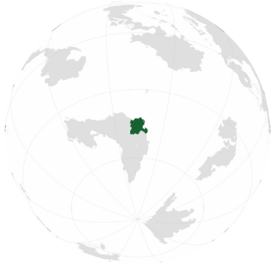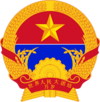Buyo
This article is incomplete because it is pending further input from participants, or it is a work-in-progress by one author. Please comment on this article's talk page to share your input, comments and questions. Note: To contribute to this article, you may need to seek help from the author(s) of this page. |
Buyonese Federative Socialist Republic 安漘联邦社会主义共和国 (Mandarin) | |
|---|---|
Motto: 世界人民大团结万岁! Shìjiè rénmín dà tuánjié wànsuì! "Long live the unity of the world's people!" | |
 Location of Buyo | |
| Capital | Gemun |
| Largest city | Mokpo |
| Official languages | Mandarin |
| Recognised national languages | Congka Hulun Jusin Tamun Sacam Velnye |
| Recognised regional languages | Over 50 languages |
| Ethnic groups (2019) | 21.4% Tamun 20.1% Jusin 13.2% Shun 12.9% Sacami 11.4% Cong 9.7% Kusinye 7.6% Hulun 3.7% Other |
| Demonym(s) | Buyonese |
| Government | Federal one-party socialist republic |
• BPWP General Secretary President | Ilyiparise Alborz |
• Vice President | To Yun'o |
• Premier | Shen Kaizhi |
• Chairman of the People's Assembly | Sohon Ulhicun |
| Legislature | People's Assembly |
| Establishment | |
| 113 BCE | |
| 472 | |
| 893-1239 | |
| 5 July 1321 | |
| 24 April 1644 | |
| 9 May 1917 - 17 November 1929 | |
| 15 June 1969 | |
| Area | |
• Total | 1,181,881 km2 (456,327 sq mi) |
| Population | |
• 2026 estimate | 89,000,000 |
• 2017 census | 86,646,492 |
• Density | 72.46/km2 (187.7/sq mi) |
| GDP (PPP) | 2025 estimate |
• Total | 1.7 trillion Rovas |
• Per capita | 19,345 Rovas |
| GDP (nominal) | 2025 estimate |
• Total | 655.107 billion Rovas |
• Per capita | 7,444 Rovas |
| Gini (2025) | 32.6 medium |
| HDI (2025) | high |
| Currency | Fiat (BYY) |
| Date format | dd-mm-yyyy |
| Driving side | right |
| Calling code | +29 |
| Internet TLD | .by |
Buyo (Mandarin: 安漘; pinyin: Ānchún; Jusin: 부여; pyongum: Buyŏ), officially the Buyonese Federative Socialist Republic (BFSR) is a country in central Narushia. It is situated in the easternmost region of central Narushia, bordered by the Usnean Ocean to the north and east and Heskurik to the west. Buyo has a land area of 1.18 million square kilometers (456,327 square miles), with a population of approximately 88 million distributed over 15 provinces and two municipalities. The capital and second most populous city is Gemun, while the most populous city is Mokpo.
The region that now comprises Buyo has been inhabited since the late Paleolithic, with settlement focused around the Paemul and the northern coast. The first organized states arose by the 6th century BCE, with the first written records dating to the 4th century BCE. Buyo's first real dynasty emerged in 121 CE with the Kyerim Kingdom. Following a civil war, the Kayanid Kingdom (472-893) took power, seeing the emergence of classical Buyonese cultures. Under the succeeding Yaksa Kingdom (893-1178) continued this cultural expansion, adopting the Varasani and Tamun scripts. The Mu Dynasty saw the formation of Buyo as a coherent state, while the Wen-Sohon Dynasty conquered to its largest extent. The Empire of Buyo was overthrown in the Buyonese Revolution, culminating in the establishment of the current Buyonese Federative Socialist Republic in 1929, under the Buyonese Peasants' and Workers' Party (BPWP). Early communist rule saw the dual industrialization of the country and sociocultural revolution, culminating in the 1969 Constitution, lessening the role of the BPWP in state affairs.
Buyo is a multiethnic country with over 65 recognized ethnic groups, with no dominant ethnicity. A shared identity has been formed around a shared ideology, defined by a national language, cultural diversity, and a common history. Buyo ranks highly in measures of ethnic equality.
Buyo is a federal one-party socialist republic constitutionally led by the BPWP. It is a member of the International Communist Network. Buyo maintains an authoritarian regime where political opposition is not permitted. It is regarded as one of the worst countries in the world for independent journalism. Currently, the Buyonese economy is growing at a rapid pace, although it still remains a developing country. It maintains a largely planned economy, save for special economic zones in Mokpo, Isun, and Muksu.
Etymology
The term "Buyo" is believed to have originated from Fu Yue (Mandarin: 傅说; pinyin: Fù Yuè), the legendary founder of the Mu clan that would later form the Mu Dynasty of the Buyonese Empire. Fu Yue was described as the son of Hapaek, the god of the Paemul River, who established the modern-day city of Ryongyon, from which the Mus ruled.
The official name of the modern state is the "Buyonese Federative Socialist Republic" (Mandarin: 安漘联邦社会主义共和国, pinyin: Ānchún Liánbāng Shèhuì Zhǔyì Gònghéguó), with the colloquial term being "Buyo" or Ānchún (安漘)', or "safe shore", a term developed following the Wen clan's arrival and takeover of Mudan. "Anchun" is believed to be a transliteration of the Manju word "Ancun", meaning "gold" or "golden", referring to the name of the Yaksa Kingdom, Anchunsaro, or "golden realm". The name ultimately derives from the Aisin (then pronounced as Anchun) river, by which the Yaksa Kingdom was founded.
History
Tool artifacts found in Ninkuta, Varasan, and Kwangju have been dated to 20000-15000 BCE, although to this date no fossil evidence of human habitation has been found. Rock art found in Nakūle Cave near Arsi dates to 10000 BCE. It is believed that prehistoric humans inhabiting the northern coasts of modern-day Buyo, particularly in Ninkuta, would later become the ancestors of the Tamun and Jusin, while those in the south would become the ancestors of the Shun and Congka.
Intensive agriculture was adopted by 5000 BCE, starting from the Paemul basin. Crops such as millet, wheat, adlay, and rice spread across the region of modern-day Buyo. In modern-day Kusimanye, barley was introduced starting in 4000 BCE. The adoption of agriculture led to the first bouts of civilization, based primarily in the Paemul and Tamun river basins, and the northern coast of Buyo. Janggang, the first true city in Buyo, emerged by 3000 BCE, based near the town of Yangdok, with other cities forming along its stretch of the Paemul, making up the Sipje Culture. Along the Tamun River and Bulhuri Lake, the Manju Culture formed, its largest settlement being Fakū, home to 5,000 people. Warfare seemed to be relatively sparse among these civilizations, suggesting some type of political unity. Archaeological evidence of the Paemul script is dated to 1600 BCE, similar to that of the Kisin script of Liberto-Ancapistan, later developing into Shun characters.
The earliest known records of a polity are attributed to Joseon, centered in the Paemul Basin and encompassing territories up to Buruna in the north and Uiju in the south. While archaeological evidence of this era is plentiful, few written records survive of their existence. What is known is that Choson held extensive trading relations both overland in Narushia and overseas. Similarly, Bukuri to the north has few records, although it is heavily attested to both in archaeological records and Tamun mythology. Its first king, Bukuri Yongson, is said to have come from a virgin birth of a magpie and a fairy. The first state with written records, Sacam, rose in the 3rd century BCE, based primarily in modern-day Varasan and Bohori provinces.
Kyerim Kingdom and States
Following the decline of Choson, Bukuri, and Sacam in the mid-2nd century BCE, various states filled the vacuum in Buyo. By this time, the modern peoples of Buyo had begun to take shape, with the proto-Shun and Jusin peoples dominating the Paemul Basin, while the Manjus and Sacamis spread around the north. Toward the west, the Velnye Kingdom slowly began expansion under the Kuche Dynasty, dominating modern-day Kusimanye.
A local petty king in the Paemul region, Ŏl Kasum, began conquering surrounding fiefdoms in 125 BCE. He would later crown himself as King of Kyerim in 113 BCE, following the conquest of the Hanyang Kingdom. Under his daughter Ŏl Aryŏng Kyerim would gain the allegiance of Cong states to its south, while in the north it struggled against Manju states. Under Kyerim, the Paemul script would be refined, developing into seal script and various demotic scripts used for everyday purposes. Ceramics, textiles, ginseng, and livestock all began to be exported as trade goods during this period. The overland tourmaline trade began developing at this time, with the Valleys exporting the crystal for luxury goods from Kyerim.
In the northeast, Xusro, the progenitor of the Kayanid dynasty, founded the Tirmis Kingdom in the city of the same name. The surrounding area of modern-day Varasan and Kuararon was ruled by his descendants for the next thousand years. The Xusronid dynasty would rule the easterly Manju states through alliances and military campaigns, beginning the centuries-long Sacami influence over the Manju peoples. The Velnye expanded west, coming into contact with the Hulun Confederacy, starting a centuries-long series of conflicts.
Kayan Kingdom
Following a power struggle between the last King of Tirmis Ardashir and his chancellor Meheran Golon, the latter took power as king, moving the capital to Kayan. This began the Kayan Kingdom in 472. This takeover largely preserved the tributary relationships that characterized the Tirmis Kingdom, although its directly-governed territories expanded significantly. Under King Meheran Golon, the kingdom would conquer the Manju states, with the most powerful one, Moko (modern-day Ilan Muke), falling by 489. Under his daughter Boran, the Kayanids would subdue the Velnye in 501, turning them into tributary peoples. Before the end of the 5th century, Kayanid armies would sack Kyerim, supplanting it as the hegemon of the Buyonese region. The Kayanids implemented bureaucratic rule, simplifying the system of bureaucratic selection into question-and-answer tests to be judged by officials and scholars. Later evolving into the Buyonese bureaucratic system, the system would survive into the 20th century.
The Kayanid Kingdom saw the emergence of the classical Sacamate cultures that predominate north and east Buyo today. Rulers such as Boran, Narseh, and Vahram patronized artists, sculptors, philosophers, and academics, with the Great Academy of Muksu having over 25,000 students at its peak. Hundreds of annals populate the records of the realm, forming the basis of the first epic of Buyo, the Book of Kings. Kayanid art and literature spread across Narushia, with architectural motifs being found as far as the United Valleys.
Following the sudden death of Rostam Sijani in 807, the Kayanids entered a period of rapid decline and strife. With the Manjus and Sacamis forming factions based on regional allegiance, political struggles consumed Kayan. In the chaos, the Velnye, Shun, and Jusin kingdoms which had tributary relations quickly declared independence. The political chaos in Kayan would escalate into a civil war following the assassination of the regent Shirin. This civil war would end inconclusively, with an east-west divide following the divides between Manju and Sacami. Following this, a series of wars would ensue, both claiming the legacy of the Kayanids, with the Manjus based in Yaksa and the Sacamis based in Muksu.
Yaksa Kingdom and Medieval Period
Following a coup against the Muksu government in 881, Kayomart Varaz launched an invasion of Yaksa-held Alcuka, capturing Biyoran Fortress. In a bid to consolidate power and prove that he had a mandate to rule, he was able to rally his loyal supporters and more reluctant warlords in his attempted conquest. Responding to the invasion was Natan Anushbeile Shah, who had recently consolidated power over the various warlords in his realm, and thus had greater fighting capability. In the first phase, the two Shahs remained at a stalemate, with the stronger Varaz struggling to rally his realm while Anushbeile could not break through Varaz's defenses. However, instabiliy within the Muksu court due to the stalemate would give way to the second phase, which was the defeat of Varaz following the fall of Biyoran Fortress to Yaksa forces. In February 893, Yaksa forces entered Muksu, and Natan Anushbeile Shah was enthroned as shahanshah of Anchunshahr (Ancunsaro). His first act was to formally proclaim the Manju peoples as Tamun people, formalizing a century of cultural drift within the Sacamate sphere.




